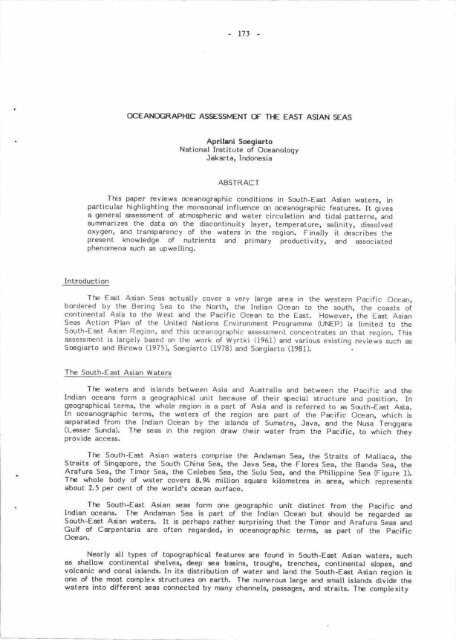Rt€@lll
Rt€@lll
Rt€@lll
Create successful ePaper yourself
Turn your PDF publications into a flip-book with our unique Google optimized e-Paper software.
- 17,<br />
OCEANMRAPHTC ASSESSMENT tr TIf EAST ASIAN 5EA5<br />
Aprilani SocAiarto<br />
National Institute of Oceanology<br />
Jakarta, Indonesia<br />
ABSTRACT<br />
This paper reviews oceanographic conditions in South-East Asian waters, in<br />
particular highlighting the monsoonal influence on oceanographic features. It gives<br />
a general assessrnent of atmospheric and water circulation and tidal patterns, and<br />
summarizes the data rt ihe discontinuity layer, temperature, salinity, dissolved<br />
oxygen' and transpareney of the waters in the region. Finally it describes the<br />
present knowledge of nutrients and pnimary productivity, and associated<br />
phenomena such as upwelling.<br />
Introduction<br />
The East Asian Seas actually cover I very large area in the western Pacific Ocean,<br />
bordered by the Bering Ses to the North, the lndian Ocean to the south, the coasts of<br />
continental Asia to the West and the Pacific Ocean to the East. However, the East Asian<br />
Seas Action Plan of the United Nations Environment Proqramme (UNEP) is limited to the<br />
Souih-East Asian Region, and this oceanographic assessment concentrales on that region. This<br />
assessrnenl is largely based on the work of Wyrtki (f96f) and various existing reviews such as<br />
Soegiarto and Birowo (1975), Soegiarto (1978) and Soegiarto (1901).<br />
The South-East Asian Waters<br />
The waters and islands between Asia and Australia and between the Pacific and the<br />
Indian oceans form a geognaphical unit because of thein special structure and position. In<br />
geographical lerms, the whole region is a part of Asia and is referred to as Soulh-East Asia,<br />
In oceanographic terms, the waters of ihe region are part of the Pacific Ocean, which is<br />
separated from the Indian Ocean by the islands of Sumatra, Java, and the Nusa Tenggara<br />
(Lesser Sunda). The seas in lhe region draw lheir water from the Pacific, to which lhey<br />
provide access.<br />
The South-East Asian waters comprise the Andaman Sea, the Straits of Mallaca, the<br />
Straits of Singapore, the South China Sea, the Java Sea, the Flores Sea, the Banda Sea, the<br />
Arefura Sea, the Timor Sea, the Celebes Sea, the Sulu Sea, and the Philippine Sea (Figure lI<br />
Tlp whole body of water covers 8.94 million sguare kilometres in area, which represents<br />
about 2.5 per cenl of the world's ocean surface.<br />
The South-East Asian seas form me geographic unit distinct from the Pacific and<br />
Indian means. Tle Andaman Sea is part of the Indian Ocean but should be regarded as<br />
South-Emt Asian waters. It is perhaps rather zurprising thet the Timor and Arafura Seas and<br />
Gulf of Carpentaria are often regarded, in oceanographic terms, as part of the pacific<br />
Ocean.<br />
Nearly all types of topographical features are found in South-East Asian waters, such<br />
as shallow continental shelves, deep sea beins, troughs, trenches, continental slopes, and<br />
volcanic and coral islands. In its distrihrtion of water and land the South-East Asian region is<br />
one of ihe most complex structures on earth. The nurneroue large and small islands divide the<br />
waters into different seas connected by many channels, passeges, and straits. The complexity














![R]€@lll](https://img.yumpu.com/7594335/1/175x260/reurlll.jpg?quality=85)
